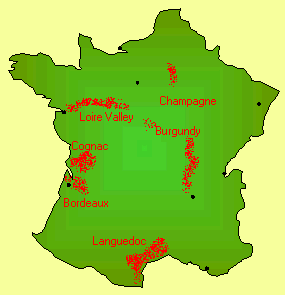The
Chemistry of Champagne
Champagne enjoys a
reputation as one of the most well-known and sought after sparkling wines,
usually consumed only on special occasions; few people enjoy the luxury of
champagne everyday!
The process of wine making was taken to a new
level when in the 17th century a Benedictine monk, Dom Perignon, noticed
that in the spring time some wines refermented, resulting in a build up
of pressure from the release of carbon dioxide, CO2, causing
the bottles to explode! To  combat
this the bottles were reinforced to give the familiar Champagne bottle.
The stopper used until that point was a simple wad of cotton that
had been soaked in oil. The first production of Champagne led to
the introduction of cork stoppers. The cork inserted into the bottle
is always cylindrical but the pressure in Champagne bottles causes the
distortion as the cork is forced out of the top of the bottle during maturation.
combat
this the bottles were reinforced to give the familiar Champagne bottle.
The stopper used until that point was a simple wad of cotton that
had been soaked in oil. The first production of Champagne led to
the introduction of cork stoppers. The cork inserted into the bottle
is always cylindrical but the pressure in Champagne bottles causes the
distortion as the cork is forced out of the top of the bottle during maturation.

Champagne
is the most northerly of the major wine growing regions in France, and
is one of the oldest vineyards in Europe. Fossil evidence shows there
were vines there millions of years ago and the number was greatly increased
in Roman times.
The trade name Champagne can only be used for sparkling wines produced
in this region, others have to use different brand names, e.g. Spunante
from Italy and Sekt from Germany.
The Champagne-making process
 combat
this the bottles were reinforced to give the familiar Champagne bottle.
The stopper used until that point was a simple wad of cotton that
had been soaked in oil. The first production of Champagne led to
the introduction of cork stoppers. The cork inserted into the bottle
is always cylindrical but the pressure in Champagne bottles causes the
distortion as the cork is forced out of the top of the bottle during maturation.
combat
this the bottles were reinforced to give the familiar Champagne bottle.
The stopper used until that point was a simple wad of cotton that
had been soaked in oil. The first production of Champagne led to
the introduction of cork stoppers. The cork inserted into the bottle
is always cylindrical but the pressure in Champagne bottles causes the
distortion as the cork is forced out of the top of the bottle during maturation.